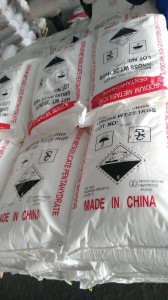Generally, the production process of sodium metasilicate is summarized into three types: one is the “continuous granulation method”, which is to pass the sodium metasilicate solution through the granulation crystallization device to directly and continuously produce particles of the required size. The quality index conforms to HG/T2568- The 94 standard requires that the product has a spherical particle appearance, high whiteness, good fluidity, and low iron content. It is a high-end product. This method is suitable for large-scale production but has strong technicality and is difficult to master. One is the “crystal dehydration method” and the “crystal crushing method”. “Crystal dehydration method”, also known as mother liquor circulation method, is to add sodium metasilicate solution to seed crystals or mother liquor to cool and crystallize. After centrifugal dehydration, dynamic drying and sieving are obtained to obtain powder and granular products. This method is difficult to produce on a large scale. The appearance and fluidity are relatively good, and the physical and chemical indicators can also meet the requirements of the HG/T2568-94 standard. “Crystal pulverization method” This method is to concentrate the sodium metasilicate solution to the required concentration, by adding seed crystals and additives to guide the solution to crystallize into a block solid, all the free water is converted into crystal water, and the solid is pulverized to become the finished product. The advantage of this method is that the investment is small, but the damage to the crystal structure is more serious, the climate environment and control conditions are more demanding, the labor intensity is high, the product whiteness is low, it is easy to absorb moisture and agglomerate, and the physical and chemical indicators are generally not reached. HG/T2568-94 standard requirements. The granular products are dust-free and can meet the export requirements; while the powder and granular products produced by the latter two methods use a lot of dust, and the export is restricted.
Our company adopts continuous granulation method.The appearance of the product is spherical particles, with high whiteness, good fluidity, and low iron content. It is a high-end product.It has strong alkaline, strong detergency, large buffer capacity, can neutralize acid dirt, emulsify fats and oils, and deflocculate inorganic substances. It can replace sodium tripolyphosphate and be used to synthesize high-efficiency detergents and metals. The cleaning agent reduces the environmental pollution of sodium tripolyphosphate, provides an excellent alkaline buffer, provides corrosion protection to metals (zinc, aluminum, etc.), and has a certain softening effect. The silicate anions contained in the sodium metasilicate can form insoluble substances with the harmful ions of Ca2+ and Mg2+ in the mud, promote the exchange of Na+, reduce the viscosity of the mud, and increase the fluidity. Therefore, sodium metasilicate is widely used in the preparation of various detergents, metal surface treatments, ceramic grinding aids, refractory raw materials, plastic and water retention agent raw materials, degreasing textile printing and dyeing auxiliaries, and paper deinking agents.

Post time: Jul-20-2021
